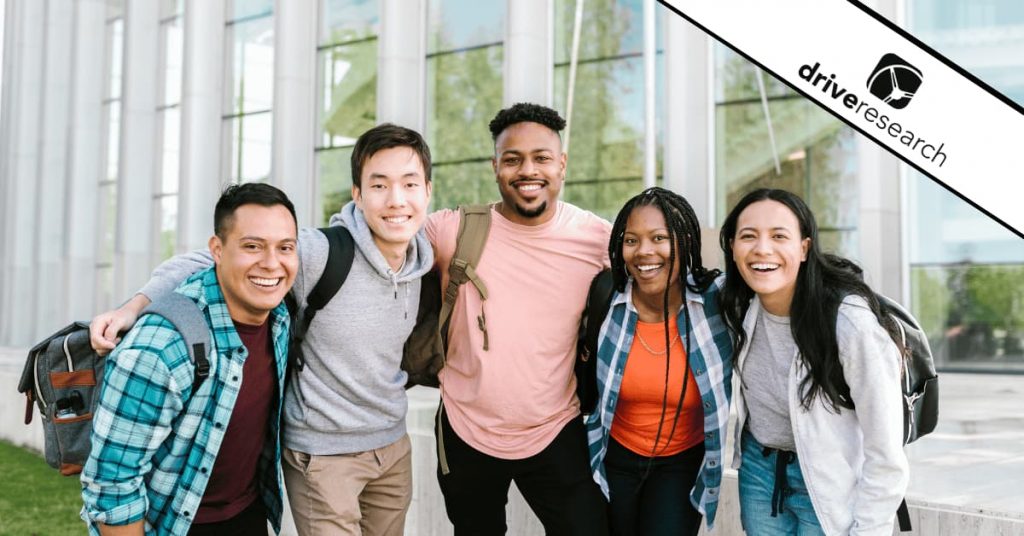
For a local university seeking to enhance its credit schedule and catalog, understanding student needs and preferences was crucial. Partnering with Drive Research, the university embarked on a qualitative focus group study to explore how students engage with Fall and Spring catalogs, as well as the overall design, content, and relevance of the materials. The goal was simple: improve the student experience, increase enrollment, and refine key informational resources for current and prospective students.
In this case study, we’ll walk through the objectives, approach, and results of the market research project. We’ll also highlight how focus groups can provide valuable insights to help higher education institutions optimize their student-facing materials and services. Let’s dive into how these insights helped the university enhance its credit schedule and increase the likelihood of enrollment.
What were the objectives of the market research?
Recently, a local university partnered with Drive Research to conduct qualitative focus group research on its credit schedule. The objectives of the market research were to gain insight and understand the importance of the Fall and Spring mailed catalogs, including usage, content, advertising, design and relevance. Improving the credit schedule for current and potential students will create a better student experience, increase likelihood of enrollment, and enhance the credit schedule and catalog. Other secondary objectives were also explored.
What was the approach for the market research?
To address the objectives at-hand, Drive Research agreed on the following structure for the focus group project. Two focus groups were be conducted: (Group 1) consisting of currently enrolled students, and (Group 2) consisting of students who have inquired with the college but did not enroll. Lists (including name, phone, and email) were provided to Drive Research.
Participants for both groups were recruited via an online recruitment screener. Approximately 1,000 emails to both groups were sent to qualify participants and gauge interest in attending a paid follow up focus group session. Fieldwork for the online survey began in early January. Results of this survey were added as a bonus to the focus group report.
A total of 14 participants were recruited for each group with 2 unpaid stand-by participants. All sign ups were mailed a confirmation letter with general FAQs, received a confirmation phone call 48 hours prior to the focus groups, and received a confirmation text the day of the focus groups. A total of 12 participants of the 14 recruited participants attended each session (86% show-rate which is exceptionally high for focus groups, particularly higher education focus groups with students.)
Both focus groups were held at the higher education institution. The inquiry group was held at 5:30 PM and the enrolled student group was held at 7:30 PM. Each focus group session lasted approximately 2 hours. Food, refreshments, and snacks were provided to both groups. As a thank you, participants were provided a $75 thank you and a code for a free 1-night Redbox DVD rental. Focus groups were audio and video recorded.
What were the results and actions taken from the market research?
Prior to the full report, the client was sent a topline report with key highlights from the focus groups a few days after the sessions were held. Although the results of the focus groups are proprietary and confidential, we can say they did provide the client with a wealth of exploratory feedback and direction to help guide their decisions. The participants helped restructure designs of the credit schedule, main website, student website, and student planner. All 4 sources were examined as part of the 2-hour scope. Several “real life” scenarios were created where participants were asked to search for information or find information live.
The outcome of the results provided the client with a clear plan and priorities of items to fix in their information materials. It also provided them with information about what to feature, what to move, and what to add to the student resources. Ultimately the focus group findings will improve these items and make them more relevant for each audience. This market research provided the higher education institution with a stronger ability to improve the student experience (SX) and increased the likelihood of enrollment among inquiry populations.
Contact Our Focus Group Company
Drive Research is a national higher education market research company located in Syracuse, NY. Our focus group services include recruitment, moderation, and reporting. Interested in talking to Drive Research about your next college or university focus group? Contact us today.



